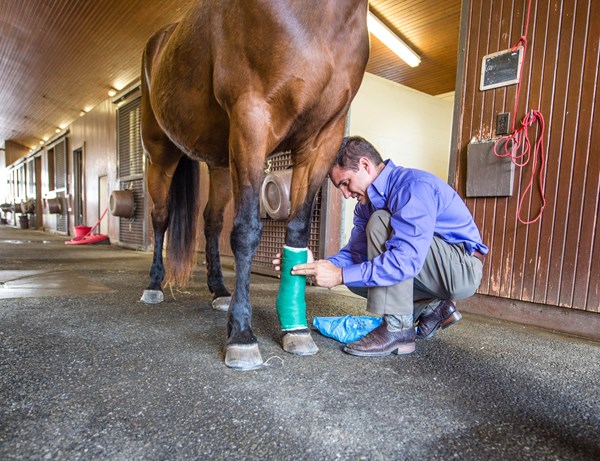Editor’s note: According to the AAEP horse owner survey, the top three things that horse owners want from vets are 24/7 coverage, a veterinarian who values them and their horse and communicates well, and a practitioner who keeps up with medical advances. With that in mind, regular installments of Keeping Up will headline recent information to keep you abreast of research and advances in the equine medical community, with some business twists added on.
 Credit: Amy Dragoo This research found that it is appropriate to extend bandage change intervals past four days if that horse is monitored closely.
Credit: Amy Dragoo This research found that it is appropriate to extend bandage change intervals past four days if that horse is monitored closely.Bandage Compression
As equine practitioners, we are often called out to treat a horse for limb wounds and/or swelling. As part of the treatment, it is not uncommon to apply compression bandages to support soft tissues and limit swelling. Until recently, most compression studies were only done in humans and dogs, but a recent study by N.C. Canada, et al, published in Equine Veterinary Journal (28 July 2016; http://onlinelibrary.wiley.com/doi/10.1111/evj.12601/full), took a look at compression bandaging in horses.
Bandages were applied for 24 hours from coronet to distal carpus on the forelimbs of eight horses. Each horse wore a distal limb compression (DLC) wrap on one leg and a pillow pad/polo wrap (DLP) on the other. Another group of eight horses wore the DLC wrap for 96 hours. The DLC wraps consisted of combine padding overlaid by brown cling gauze, which was overlaid with an elastic self-adherent wrap. Pressure was evaluated using a portable, electronic manometer placed dorsally and laterally on the cannon bones. Because of the distinctive shape of the equine cannon bone, measurements showed that a bandage applies more pressure to the dorsal area than to the lateral part of the limb.
Assuming a bandage doesn’t need to be changed daily due to drainage issues or monitoring requirements, the study found that the DLC bandages were able to exert sufficient pressure (>120 mmHG) for up to 96 hours. The authors concluded that with this data in mind, it is appropriate to extend bandage change intervals past four days. However, as limb edema diminishes, a bandage might loosen enough to necessitate more frequent bandage changes. Both the DLC and DLP maintained pressures beyond what is recommended for effective edema reduction as demonstrated in human studies.
Another interesting point is that the brown gauze compression contributed 48% of the overall pressure, with 52% contributed by the elastic tape. Adding additional layers to a two-part bandage is not recommended.
Business Take Home Message
Sharing this type of information with horse owners can help them properly care for a bandaged horse, and perhaps save them time in bandage changing with no problem in maintaining compression.








